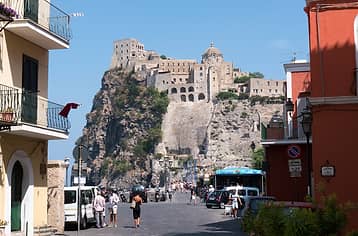Ischia Ponte


There are six towns on the island of Ischia, and the largest is the town of Ischia, which is divided into two areas: Ischia Porto and Ischia Ponte. Ischia Ponte is where the famous Castello Aragonese is located, one of the most iconic symbols of the island.
How to Get to Ischia Ponte
How to Get to Ischia Ponte
Ferries and hydrofoils run daily between the island of Ischia and the mainland port cities of Naples (Napoli) and Pozzuoli all year round. In spring and summer (from the beginning of May to the end of September) there are also direct ferries from a number of other locations in Campania like Capri, Procida, Sorrento, Amalfi, Positano, and Salerno.
Book your ferry ticket from Naples to Ischia
The nearest port to Ischia Ponte is Ischia Porto, located just a couple of kilometers away. If you are up for walking, you can reach Ischia Ponte on foot, walking the length of Corso Vittorio Colonna and then continuing on along Via Seminario and Via Luigi Mazzella. It will take about 30 minutes, but you can break it up with a cool drink in one of the bars along the route or shopping in the many boutiques and souvenir shops.
If you booked a hotel or other accommodation in Ischia Ponte, be sure to book your ferry to Ischia Porto. There are other ferry ports on the island near Forio and Casamicciola Terme, located much farther away. The ports in Lacco Ameno and Sant’Angelo are just marinas for private boats).
You can also reach Ischia Ponte by bus; take bus 7 that departs from Piazza Trieste in Ischia Porto and takes about 10 minutes to reach Ischia Ponte.
If you prefer to take a taxi, you'll find taxis waiting at the stand just opposite the ferry port. Fares are between EUR 12 and 15 one way.
Otherwise, you can reach Ischia Ponte by car if you've embarked your vehicle on the ferry to Ischia (all non-residents of the region of Campania can bring their cars all year round). We don't recommend this option in the summer as traffic can be heavy and parking difficult to find.
Sights in Ischia Ponte
Sights in Ischia Ponte
Ischia Ponte is one of the most historic and best-preserved villages on Ischia island, a former fishermen's village set at the foot of the island's noble castle. At the time it was called “the village of Celsa” as it was home to a number of mulberry tree plantations (called "gelso" in Italian).
The original architecture of the village is largely intact, made up of narrow lanes crowded with historic homes. There is a mix of humble island residences and baroque aristocratic palaces like the Palazzo dell’Orologiaio, today home to a small but interesting marine museum, the Museo del Mare.
The Aragonese Castle
The Castello Aragonese is a citadel with churches, convents, prisons, terraces, and historic residences encircled by a defensive wall, and is set on an islet off the coast of Ischia but connected to the mainland by a bridge built in the 1300s.
Open daily all year
Hours: 9AM to sunset
Tickets: EUR 10 for adults; EUR 6 for children 10 to 14; free for children under 10
Book a guided tour by contacting segreteria@castelloaragonese.it or phoning +39 081 992834
The path to visit the castle is about 2 kilometers and takes about 1.5 hours
There are a number of flights of stairs, so the castle is not accessible to wheelchair users
This medieval castle is the most famous symbol of Ischia, an island within the island. The first settlement can be dated to the 5th century BC, and the village was later enlarged and fortified by the Romans. In the 1400s, Alfonso d’Aragona built the castle in its present form and used it as a fortress during wartime and as a residence during peace. The end of the Aragon reign and the waves of plague in the 1600s brought gradual abandonment of the castle, which was used as a prison during the Bourbon reign. After the unification of Italy, the castle was abandoned until 1912, when is was purchased at auction by the Mattera family, who began restoring the complex. It is still owned by the same family today.
The castle offers beautiful views inland to the peak of Mount Epomeo and out over the Bay of Naples to Mount Vesuvius on the mainland, plus the Baia di Cartaromana, the small bay set just below the castle that is home to two towers: Michelangelo Tower and Guevara Tower. It is also the centerpiece to the Festa di Sant'Anna each July, the most important local celebration.
Three things to do in Ischia Ponte
Visit the Castello Aragonese
Take a dip at the Scogli di Sant’Anna
Stroll through the historic center
Beaches at Ischia Ponte
Beaches at Ischia Ponte
Cartaromana Beach: just steps from the Castello Aragonese, this small bay is known for its pretty Sant’Anna coastal formations There are a number of thermal springs that come up through the seafloor and heat the water.
Spiaggia del Pescatori: a pretty sandy beach between Ischia Porto and Ischia Ponte
Hotels in Ischia Ponte
Hotels in Ischia Ponte
Dining in Ischia Ponte
Dining in Ischia Ponte
There are a number of excellent eateries serving traditional island specialties in Ischia Ponte.
Our favorites are:
Da Ciccio
Da Cocò
Aglio, Olio e Pomodoro
FAQ - Frequently asked questions
Castello Aragonese: hours, tickets and prices
Open: daily all year from 9AM to sunset
Tickets: EUR 10 for adults; EUR 6 for children 10 to 14; free for children under 10